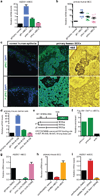GLI activation by atypical protein kinase C ι/λ regulates the growth of basal cell carcinomas
- PMID: 23446420
- PMCID: PMC3761364
- DOI: 10.1038/nature11889
GLI activation by atypical protein kinase C ι/λ regulates the growth of basal cell carcinomas
Abstract
Growth of basal cell carcinomas (BCCs) requires high levels of hedgehog (HH) signalling through the transcription factor GLI. Although inhibitors of membrane protein smoothened (SMO) effectively suppress HH signalling, early tumour resistance illustrates the need for additional downstream targets for therapy. Here we identify atypical protein kinase C ι/λ (aPKC-ι/λ) as a novel GLI regulator in mammals. aPKC-ι/λ and its polarity signalling partners co-localize at the centrosome and form a complex with missing-in-metastasis (MIM), a scaffolding protein that potentiates HH signalling. Genetic or pharmacological loss of aPKC-ι/λ function blocks HH signalling and proliferation of BCC cells. Prkci is a HH target gene that forms a positive feedback loop with GLI and exists at increased levels in BCCs. Genome-wide transcriptional profiling shows that aPKC-ι/λ and SMO control the expression of similar genes in tumour cells. aPKC-ι/λ functions downstream of SMO to phosphorylate and activate GLI1, resulting in maximal DNA binding and transcriptional activation. Activated aPKC-ι/λ is upregulated in SMO-inhibitor-resistant tumours and targeting aPKC-ι/λ suppresses signalling and growth of resistant BCC cell lines. These results demonstrate that aPKC-ι/λ is critical for HH-dependent processes and implicates aPKC-ι/λ as a new, tumour-selective therapeutic target for the treatment of SMO-inhibitor-resistant cancers.
Figures




Comment in
-
aPKC ι/λ: a potential target for the therapy of Hh-dependent and Smo-inhibitor-resistant advanced BCC.Acta Biochim Biophys Sin (Shanghai). 2013 Jul;45(7):610-1. doi: 10.1093/abbs/gmt053. Epub 2013 May 17. Acta Biochim Biophys Sin (Shanghai). 2013. PMID: 23685738 No abstract available.
References
-
- Dijkgraaf GJP, et al. Small molecule inhibition of GDC-0449 refractory smoothened mutants and downstream mechanisms of drug resistance. Cancer Research. 2011;71:435–444. - PubMed
Publication types
MeSH terms
Substances
Grants and funding
LinkOut - more resources
Full Text Sources
Other Literature Sources
Molecular Biology Databases
Miscellaneous

